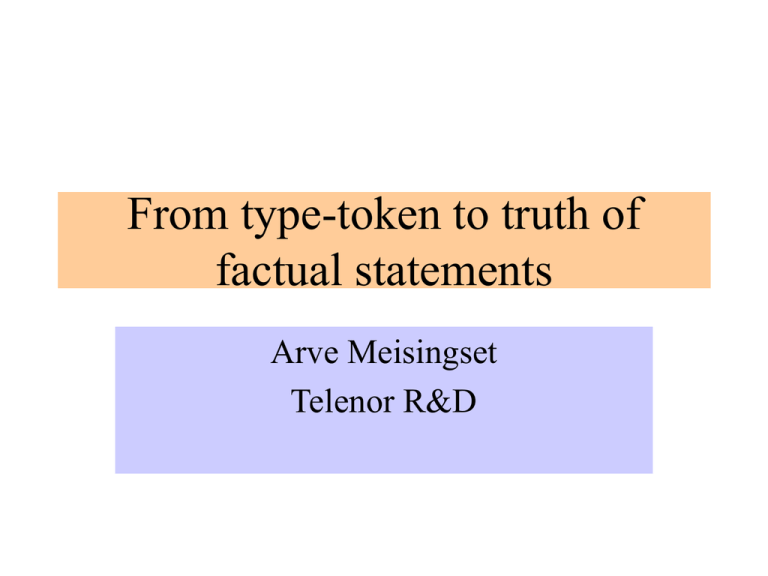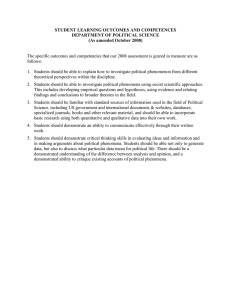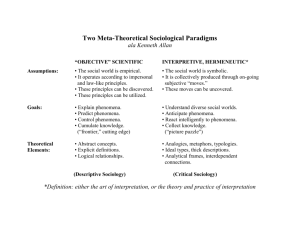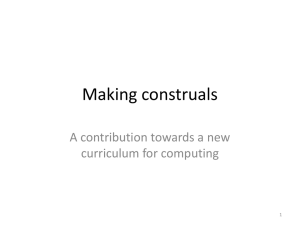From type-token to truth of factual statements Arve Meisingset Telenor R&D
advertisement

From type-token to truth of factual statements Arve Meisingset Telenor R&D Arve’s views • Extreme nominalist; phenomena (both classes and instances) are data in some observer automaton; ref. the War of Universals • Phenomenologist; neither the real world nor concepts exist (the way phenomena exist), repeated observations organise the world of phenomena • Finitist; real numbers are functions with no stop condition, there exists no infinity, no continuity, and no sets; ref. Cantor • Constructivist; equations are just boundary conditions of algoritms; an equation without an algortm is an incomplete specification • Relativist; all phenomena must be refered to some observer phenomenon • Automaton; we cannot claim to more general than the automata we can • describe without making claims which do not denote etc.! The type-token principle • Constants are globally unique – John, 1, Persons, … • Variables are unique within the scope of their quantifier – x, person, … Tokens & inscriptions PersonsClasses Cars Classes Bill Persons Mary Persons Bill =William Four different tokens Three different inscriptions On paper Types & strings PersonsClasses Cars Classes Bill Persons Mary Persons Bill =William Similar tokens are of the same type Similar inscriptions are of the same string C P e r s o n l a B i M y W m Classes Persons Cars Bill Mary = William Behind paper Formal structures Sets PersonsClasses Cars Classes Bill Persons Mary Persons Bill =William P C e r s o n l a B i M y W m Classes Persons Cars Bill Mary = William The set of Terms is the subset of strings that denote entities Formal structure Denotations Bill = William P C e r s o n l a B i M y W m Classes Persons Cars Bill Mary = William , x, (, ), ^ , Denotes x ( Denotes (Bill, x) ^ Denotes (William, x) ) However, this is a Syntactical mapping only. Is this all wrong? Ogden’s triangle Terms Names Denotes Formal semantics Concepts ’Real world’ semantics Phenomena Things In the real world? Ideas Formal structures Inside heads? Wittgenstein’s picture theory for descriptive statements Terms ’Real world’ semantics John loves Mary has-age 18 Isomorphic mapping Phenomena Algorithmic assignment of Truth to simple factual statements about instances Phenomenon Statement Denotation - If 1. Observation + 3. ’This is John’ i.e. pointing out and delimiting 2. ’John exists’ + then assign the Truth value True to the Statement else in all other cases assign the Truth value False - Observation and labelling of instances John Hand that points Observation Phenomenon Name Observer (1) and his medium, denotes this John as observed from a second Observer (2) Both data and phenomena are inside the observer, and the denotations, as well No room for Ideas or Things! Activity theory Remark on Sovjet philosophy Terms Denotes Concepts are not created as ideas inside somebodies’ head Materialistic Marxistic Theory Phenomena are created through interactions with the real world Different phenomena of the same thing Does this ’real world’ entity exist? Does it belong to any class? Person Employee Person observer Company Father Person in child role Husband Organism Biologist Person in wife role Relationships as Dependencies between phenomenon instancies Person Dependency Containment Employee Person observer Company Father Person in child role Husband Organism Person in wife role Biologist Not role and entity categories, but phenomena are roles relative to each other Phenomena observing phenomena Population 1 Person Employee Company Employer Series of Observations create paths of surordinate phenomena Parallel obervations become subordinates of the same phenomenon Strong correlations are stated as dependencies between phenomena Classification Remark on the War of Universals Schema System S Person Employee Company P Population 1 Homomorphic mapping Employee Person Person Company Employee Classes are derived inside some observer, and created before instances Conclusions? 1. 2. 3. 4. 5. 6. Phenomena and classes do not exist out in the ’real world’; if the real world exists, it is not relevant to us However, we are concerned with objective, i.e. reproducible, observations We depend on the reliability of the instrumentation – the instruments shape the activities and data, and vice versa We do not observe relationships; they are made of the sequences of the observations Denotations, modelling, descriptions and synonymity are all synonyms, and have to be explicitely stated Hence, specifications without denotations are neither Models nor Descriptions! Questions? Do numbers exist? Do trolls exist? other than as data? Do humans exist, in what sense? Can we do away with types & strings, and stick to tokens & inscriptions only?







